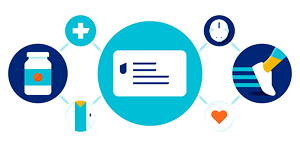Think back to the last time you booked an in-person appointment with your doctor. You had to take time out of your day to call their office and decide on a date. Maybe you had to tell your employer that you needed time to do all of this.
When the day eventually arrived, you had to get in your car — or take public transportation — to get to your appointment. And once you got to the office, you had to wait in a room with other people, some of whom were sneezing and coughing.
Telehealth is the “cure” to all that inconvenience. You can visit with a healthcare provider without the hassle of traffic, waiting rooms or other people’s germs. You can do it all from the comfort of your own home or another private location. And it requires less time away from your employer.
In this article, we’ll talk about what telehealth is and different situations where it may be a better choice than an in-person office visit.
Want to skip the waiting room? Our telehealth membership provides care for general medicine, behavioral health and dermatology.
What is telehealth?
Ever since telehealth became popular during the COVID-19 pandemic, you’ve probably heard terms like virtual care, telemedicine and telehealth used interchangeably. They all mean basically the same thing: that you can be seen by a healthcare provider, virtually, whether it’s via a secure video call or web portal.
What is a telehealth appointment?
When you have a telehealth appointment, also called a virtual visit, you do a video call with a healthcare provider. That could be on your laptop, smartphone or tablet. Since your audio and video are both on, you can interact with them just like you would in an in-person appointment.
And telehealth appointments don’t just take the place of regular doctor’s visits, where you might talk to a provider about your cold or flu symptoms or ask them about a minor rash. You can meet with different kinds of providers, such as mental health professionals or dermatologists (skin doctors).
When does it make the most sense to have a virtual visit?
Here are 9 situations where you might prefer a telehealth visit over an in-person one.
Situation #1. You’re more comfortable doing talk therapy at home.
You may feel more comfortable talking about personal topics with a mental health professional when you’re in the comfort of your own home. It’s not always easy to sit in front of another person in a live setting and talk about relationship troubles or troubling thoughts.
With certain telehealth services — like Teladoc Health’s Mind Your Health™, which is not insurance — you can meet with your mental health provider via live video sessions. They’ll also help draw up a personalized care plan for you. That might include a mix of:
- Access to online resources, such as relevant content, self-guided tours and activities to complete between sessions
- Coaching
- Talk therapy
Having the ability to access providers outside of normal office hours is especially helpful if you’re experiencing a crisis and need help immediately.
Situation #2. You don’t feel well enough to drive to the doctor.
Let’s say you wake up with flu-like symptoms. Your body aches, you have a bad cough and a fever. The last thing you’re going to want to do is get dressed, get out the door and sit in a waiting room until it’s your turn to see the doctor.
That’s where a telemedicine membership service — such as HealthiestYou by Teledoc, which is not insurance — might come in handy. It gives you access to a network of physicians who can diagnose and treat you while you’re still in your pajamas. They can even prescribe you medication over the phone — and send the prescription to your local pharmacy.
Situation #3. You’re dealing with a skin issue and want some privacy.
If you’ve had a breakout of adult acne or a rash has formed along your hand, it’s understandable that you’d want to see a healthcare provider without leaving your home. That’s where a telehealth visit with a dermatologist, through a program like HealthiestYou, could be useful.
Besides rashes and acne, they can do a virtual exam of skin issues like:
- Eczema, a skin condition that causes the skin to become dry, itchy and inflamed
- Psoriasis, a skin condition where patches of skin become scaly and inflamed
- Rosacea, a skin condition that causes redness, pimples and visible blood vessels on the face or eyes
The dermatologist can even create a treatment plan and prescribe medicine to help treat whatever skin condition you may be dealing with. And they may book an in-person follow-up if they want to take a closer look at your skin.

Situation #4. You’re unsure if you should go to urgent care or the emergency room.
It’s the middle of the night or the weekend, and your child has a fever. Since it’s outside of normal office hours at your doctor’s office, you only have a few other options.
You could go to an urgent care, but the urgent cares in your area may not be open 24/7. Even though you don’t need an appointment to see a provider at an urgent care, you may end up waiting to see one anyway, depending on how many others are there ahead of you.
That’s where telehealth comes into play. With a 24/7 telehealth service, you can schedule a virtual visit with a healthcare provider at any time — even long after most doctor’s offices or some urgent cares are closed.
A provider can help you make an informed decision about whether your child needs to be seen in person. You can talk about whether the symptoms warrant immediate medical attention (i.e., the ER), or you can wait until your provider’s office is open the next day or weekday.
Enter your ZIP code to find the virtual care plan options available in your area.
Situation #5. Your doctor wants to discuss test results.
You recently saw your doctor for an in-person visit and they did some lab work or other tests — maybe a routine blood draw or Pap smear. And they wanted you to schedule a follow-up visit to discuss the results.
That’s something you can do virtually. Rather than going back into the office, you and your doctor can discuss the results during a telehealth call. Make sure to jot down any questions you might have when they walk you through the results.
If your doctor wants to do another follow-up test, that might require you to schedule an in-person visit. But the results can always be given over the phone or via video chat.
Situation #6. You live in a rural area.
One of the biggest benefits of telemedicine is that it gives you access to healthcare providers you may not normally have access to. For example, if you live in a rural area and have to drive a great distance to a doctor’s office or urgent care, a virtual visit could be a much more convenient option. They could also save you a lengthy trip to an urgent care or hospital if your symptoms are more treatable than you expected.
If, during the virtual visit, your provider prescribes you medicine, you can have them send it to your local pharmacy. And if that happens to be far away from your home too, you may even be able to get your prescriptions delivered to your door.
Situation #7. You have mobility issues.
Whether it’s an older adult who’s not moving as well as they used to or someone who uses a wheelchair or walker to get around, mobility issues can make in-person doctor visits more than just an inconvenience. They can be a real source of stress and anxiety.
A telehealth visit can easily turn a potential hassle upside down. And if you have trouble with technology — or need an extra set of hands to take notes during the call — have a friend, spouse or grandchild nearby for added assistance.
Situation #8. You need to schedule lots of follow-up visits.
If you’re dealing with a chronic condition, such as heart disease or diabetes, and your treatment plan includes regular check-ins with your doctor, virtual visits may make it easier to be consistent with them. Plus, you won’t have to be in and out of a doctor’s office every few weeks or months.
If you wear equipment that monitors your health, such as a heart monitor or blood sugar monitor, your doctor can also give you updates on the data they’re being fed.
Situation #9. You have a baby or young child.
If you’re a parent, it can be tough to line up childcare while you go to an in-person doctor’s appointment, especially if it’s last minute. Virtual visits could make that a lot more manageable.
Learn more about virtual care plan options, or call a licensed insurance agent at 1-844-211-7730 for more information.
For informational purposes only. This information is compiled by UnitedHealthcare and does not diagnose problems or recommend specific treatment. Services and medical technologies referenced herein may not be covered under your plan. Please consult directly with your primary care physician if you need medical advice.
Compliance code:
51804-X-1224











